Ever walked out of the office at 5 p.m. and felt like you needed a whole new wardrobe just to make it to dinner? You’re not alone. The shift from day to night doesn’t have to mean hauling a second bag full of clothes. With just two pieces - and a few smart swaps - you can go from professional to polished without changing your whole outfit.
Why Two-Piece Outfits Are the Secret Weapon
Most people think of a two-piece outfit as just a blazer and pants, or a top and skirt. But when you treat each piece as a modular unit, you unlock serious versatility. The key isn’t buying more clothes - it’s choosing pieces that can play multiple roles. A structured blazer isn’t just for meetings. A silk camisole isn’t just for layering. When paired right, they become chameleons.In New York, where commutes are long and schedules are tight, people who master this trick save time, money, and stress. You don’t need a closet full of dresses. You need two smart pieces that work together - and know how to tweak them.
The Basic Formula: Top + Bottom That Talk to Each Other
Not all two-piece sets are created equal. The best ones share a few traits:- The top and bottom are cut from the same fabric or color family
- They’re designed to be worn together - but also apart
- They’re not too tight, not too loose - just right for movement
Take a navy wool blazer and matching trousers. Alone, the blazer looks like workwear. The trousers? Barely noticeable. But together? Instant power suit. Now, take off the blazer. Swap the blouse for a fitted black turtleneck. Add a chunky gold necklace. Slip into heeled ankle boots. Suddenly, you’re at a rooftop bar, not a boardroom.
This isn’t magic. It’s design. Brands like The Row, Cuyana, and even Zara’s higher-end lines build pieces with this in mind. Look for items labeled "separates" - they’re made to mix and match, not just match.
Swap #1: The Top Upgrade
Your daytime top is probably safe. Maybe a button-down, a knit, or a simple tee. It’s functional. But it’s not exciting. That’s your opening.Here’s what to do: Replace it with something that adds texture, shine, or silhouette. No need to go full glam. Just change the vibe.
- Swap a cotton button-down for a satin camisole - it catches the light differently after dark
- Trade a plain tee for a lace-trimmed tank - subtle, but it whispers elegance
- Layer a silk scarf over a turtleneck - instantly adds movement and luxury
One woman I know wears the same cream knit top from 9 a.m. to 9 p.m. All she changes is the underlayer. At lunch, it’s a simple camisole. At dinner, she adds a thin gold chain that sits just below her collarbone. That’s it. No one notices the top stayed the same. They notice she looks different.
Swap #2: The Bottom Transformation
Your pants or skirt is the anchor. It’s the foundation. And that’s why it’s the perfect place to make a quiet but powerful shift.Here’s the trick: Change the footwear and the fit. Same bottom. Different energy.
- Dark wash jeans? Swap your loafers for pointed-toe ankle boots. Add a belt that nips the waist. Instant edge.
- Tailored trousers? Roll the cuffs by half an inch. It shortens the leg visually and feels more casual. Pair with mules instead of pumps.
- A midi skirt? Tuck in your top tighter. Add a cropped jacket. The silhouette goes from corporate to cool.
One rule: never change the bottom color. Keep it neutral - black, navy, charcoal, or deep brown. That way, you can swap tops freely without clashing. Your bottom becomes your silent partner.

Accessories: The Silent Co-Conspirators
You don’t need to buy new accessories. You just need to rearrange what you already own.- Take off your minimalist watch. Put on a bold cuff or stacked rings.
- Swap your tote for a small clutch. Even if it’s just a black crossbody you already own.
- Change your jewelry material. Gold for day, silver for night - or vice versa. It changes the whole tone.
- Roll up your sleeves during the day. Let them fall naturally at night. Small, but it signals a shift.
One pro tip: carry a small pouch in your bag with two things - a lipstick and a hair tie. A swipe of red lipstick changes your face. A quick ponytail or bun changes your whole energy. You don’t need a mirror. You just need to know what works.
Real Examples, Real Results
Let’s say you’re wearing this outfit at 10 a.m.:- Blazer: Navy wool, structured
- Top: White button-down, tucked in
- Bottom: Black tailored trousers
- Shoes: Low block heels
- Bag: Medium leather tote
By 7 p.m., here’s what you’ve changed:
- Blazer: Removed
- Top: Replaced with black silk camisole
- Bottom: Same - but cuffs rolled up
- Shoes: Switched to black pointed-toe mules
- Bag: Swapped for a small metallic clutch
- Accessories: Added gold hoop earrings and a thin chain necklace
- Lipstick: Applied deep berry
That’s it. You changed six elements. But only three were actual clothing items. The rest? Just adjustments. The blazer and trousers - your two core pieces - stayed the same. You didn’t need a second outfit. You just needed to know how to unlock the second version.
What Not to Do
Some people think day-to-night means going from plain to flashy. That’s not it. It’s about refining, not reinventing.Avoid these traps:
- Wearing a sequin top with work pants - it looks like you’re trying too hard
- Changing your entire shoe style - if you wore flats, don’t suddenly wear stilettos unless your feet can handle it
- Adding too many accessories - one statement piece is enough. More looks messy
- Wearing the same top with a totally different bottom - unless it’s intentional, it looks accidental
The goal is cohesion. You want people to think, "You look great," not, "Did you change outfits?"

Building Your Two-Piece System
You don’t need a dozen combinations. Start with one. Then add one more.Try this:
- Pick one blazer or structured jacket you love
- Pick one neutral bottom that fits well - trousers, skirt, or even dark jeans
- Find two tops that work with both: one simple, one slightly dressier
- Choose two pairs of shoes: one flat, one heel
- Keep one clutch and one small bag on hand
That’s five items - and you’ve built four different looks. Two for day, two for night. And you can rotate them all week.
People think capsule wardrobes mean boring. They don’t. They mean smart. The most stylish people in the city don’t have 50 outfits. They have 5 core pieces that do 10 jobs.
Final Tip: Test It Before You Commit
Try this next week. Wear your work outfit. At 4 p.m., take a photo. Then make your two-piece switch. Take another photo. Look at them side by side. Do you feel like a different person? If yes - you’ve nailed it.You don’t need a stylist. You don’t need a budget. You just need to know that your outfit doesn’t have to end when your workday does. It can evolve - quietly, confidently, and without a single extra purchase.
Can I do a day-to-night switch with just one piece?
Technically, yes - but it’s harder. A long dress or jumpsuit can work, but it’s harder to transition from professional to evening without looking mismatched. Two pieces give you control. You can remove one to tone down, or keep one to stay grounded. It’s more reliable.
What if I don’t own a blazer?
No problem. Swap the blazer for a structured cardigan, a cropped moto jacket, or even a long-line vest. The key is structure. If it holds shape and adds polish, it works. A denim jacket won’t cut it for a formal night out - but a wool or velvet one might.
Do I need to buy new clothes for this?
No. Most people already have the pieces they need. The trick is rethinking how they’re worn. Look at your closet. What’s a top you only wear to work? What’s a bottom you never pair with anything else? That’s your starting point. You’re not shopping - you’re unlocking.
How do I know what colors work together?
Stick to a neutral base - black, navy, gray, beige. Then add one accent color in your top or accessories. If your bottom is navy, your top can be cream, white, or burgundy. No need to match exactly. Just stay within the same family. Avoid mixing warm and cool tones unless you’re confident - it can look off.
Is this only for women?
Not at all. Men can do this too. Swap a button-down for a turtleneck under the same blazer. Change dress shoes for loafers. Add a silk pocket square. Remove the tie. That’s a full day-to-night shift in three moves. The principle is the same: structure + subtle change = new look.

